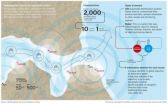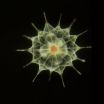A step toward lead-free electronics
2010-10-05
(Press-News.org) Research published today by materials engineers from the University of Leeds could help pave the way towards 100% lead-free electronics.
The work, carried out at the UK's synchrotron facility, Diamond Light Source, reveals the potential of a new manmade material to replace lead-based ceramics in countless electronic devices, ranging from inkjet printers and digital cameras to hospital ultrasound scanners and diesel fuel injectors.
European regulations now bar the use of most lead-containing materials in electronic and electrical devices. Ceramic crystals known as 'piezoelectrics' are currently exempt from these regulations but this may change in the future, owing to growing concerns over the disposal of lead-based materials.
Piezoelectric materials generate an electrical field when pressure is applied, and vice-versa. In gas igniters on ovens and fires, for example, piezoelectric crystals produce a high voltage when they are hit with a spring-loaded hammer, generating a spark across a small gap that lights the fuel.
The most common piezoelectric material is a ceramic crystal called lead zirconium titanate, or PZT.
Using a high intensity X-ray beam at the Diamond Light Source, the University of Leeds researchers have now shown that a simple, lead-free ceramic could potentially do the same job as PZT.
"With the 'Extreme Conditions' beamline at Diamond we were able to probe the interior of the lead-free ceramic- potassium sodium bismuth titanate (KNBT) to learn more about its piezoelectric properties. We could see the changes in crystal structure actually happening while we applied the electric field," said Tim Comyn, lead investigator on the project."
"PZT is the best material for the job at the moment, because it has the greatest piezoelectric effect, good physical durability, and can be radically tailored to suit particular applications," said Adam Royles, PhD student on the project. "The lead-free ceramic that we have been studying is lightweight and can be used at room temperature. This could make it an ideal choice for many applications."
In the medical field, PZT is used in ultrasound transducers, where it generates sound waves and sends the echoes to a computer to convert into a picture. Piezoelectric ceramics also hold great potential for efficient energy harvesting, a possible solution for a clean sustainable energy source in the future.
The Leeds team will continue to work at Diamond to study the transformation induced by an electric field at high speed (1000 times per second) and under various conditions using state of the art detectors.
The results of the work are published online in the journal Applied Physics Letters.
INFORMATION:
For further information:
Paula Gould, University of Leeds press office: Tel 0113 343 8059, email p.a.gould@leeds.ac.uk
Sarah Boundy, Diamond Light Source: Tel 01235 778639/07920 296957, email sarah.boundy@diamond.ac.uk
Silvana Westbury, Diamond Light Source: Tel 01235 778238/07841 432780, email silvana.westbury@diamond.ac.uk
Notes to Editors
1. The paper, 'Electric- field-induced phase switching in the lead free piezoelectric potassium sodium bismuth titanate ', is available online in the journal Applied Physics Letters (doi: 10.1063/1.3490235).
2. The 2008 Research Assessment Exercise showed the University of Leeds to be the UK's eighth biggest research powerhouse. The University is one of the largest higher education institutions in the UK and a member of the Russell Group of research-intensive universities. The University's vision is to secure a place among the world's top 50 by 2015. www.leeds.ac.uk
3. The Faculty of Engineering at the University of Leeds is ranked 7th in the UK for the quality of its research (2008 Research Assessment Exercise); an impressive 75% of the Faculty's research activity rated as internationally excellent or world leading. With 700 academic and research staff and 3,000 students the Faculty is a major player in the field with a track record of experience across the full spectrum of the engineering and computing disciplines. The Faculty of Engineering is home to five schools: civil engineering; computing; electronic and electrical engineering; mechanical engineering; process, environmental and materials engineering. www.engineering.leeds.ac.uk
4. Diamond Light Source is funded by the UK Government via the Science and Technology Facilities Council (STFC) and by the Wellcome Trust. www.diamond.ac.uk
Diamond generates extremely intense pin-point beams of synchrotron light of exceptional quality ranging from x-rays, ultra-violet and infrared. For example Diamond's X-rays are around 100 billion times brighter than a standard hospital X-ray machine or 10 billion times brighter than the sun. Many of our everyday commodities that we take for granted, from food manufacturing to cosmetics, from revolutionary drugs to surgical tools, from computers to mobile phones, have all been developed or improved using synchrotron light.
Diamond brings benefits to:
Biology and medicine. For example, the fight against illnesses such as Parkinson's, Alzheimer's, osteoporosis and many cancers will benefit from the new research techniques available at Diamond.
The physical and chemical sciences. For example, in the near future, engineers will be able to image their structure down to an atomic scale, helping them to understand the way impurities and defects behave and how they can be controlled.
The Environmental and Earth sciences. For example, Diamond helps researchers to identify organisms that target specific types of contaminant in the environment which can potentially lead to identifying cheap and effective ways for cleaning polluted land.
ELSE PRESS RELEASES FROM THIS DATE:
2010-10-05
Palo Alto, CA—Geologists have found evidence that some 55 million years ago a river as big as the modern Colorado flowed through Arizona into Utah in the opposite direction from the present-day river. Writing in the October issue of the journal Geology, they have named this ancient northeastward-flowing river the California River, after its inferred source in the Mojave region of southern California.
Lead author Steven Davis, a post-doctoral researcher in the Department of Global Ecology at the Carnegie Institution, and his colleagues* discovered the ancient river system ...
2010-10-05
Revenge cuts both ways in the Israeli-Palestinian conflict. Scientists of the University of Zurich, the Massachusetts Institute of Technology, and Tel Aviv and Quinnipiaq Universities show that attacks by either side lead to violent retaliation from the other. Both Israelis and Palestinians may underestimate their own role in perpetuating the conflict.
A team of scientists from the University of Zurich, the Massachusetts Institute of Technology, and Tel Aviv and Quinnipiaq Universities have found that attacks by both Israel and Palestinians lead to violent retaliation ...
2010-10-05
DURHAM, N.C. – Most doctors are spending a good deal of time counseling their patients about diet and weight loss, but for the most part, it isn't making any difference, according to a new study appearing in the American Journal of Preventive Medicine.
Duke University Medical Center researchers recorded the conversations between 40 primary care physicians and 461 of their overweight or obese patients over an 18-month period. Investigators didn't tell them what they were listening for – only that they wanted to record the encounters to see how doctors talked about health. ...
2010-10-05
PROVIDENCE, RI -- New research from Rhode Island Hospital found that reduced levels of brain-derived neurotrophic factor (BDNF), a protein in the brain that encourages growth of neurons, may be a trait marker for individuals with psychogenic non-epileptic seizures (PNES) (seizures that are psychological in origin). The findings are published in the October 4, 2010, issue of Neurology, the medical journal of the American Academy of Neurology.
Past studies have shown decreased levels of BDNF in the serum of patients with psychiatric disorders such as major depressive disorder ...
2010-10-05
The system has been designed by scientists from this Madrid university for Núcleo CC, a company which develops surveillance systems for the maritime and aeronautic sectors. The first prototype will be used in the near future in Cape Verde (Africa). Two types of sensors have been deployed there: a set of radars and a series of AIS (Automatic Identification System), which allow ships to communicate their position and give other relevant data on their location and characteristics. These two types of sensors offer complementary data which can be fused in order to obtain better ...
2010-10-05
LONDON, UK—After a decade of joint work and scientific adventure, marine explorers from more than 80 countries, including six scientists from the Marine Biological Laboratory (MBL), today delivered the first global Census of Marine Life revealing what, where, and how much lives and hides in the world's oceans. In one of the largest scientific collaborations ever conducted, more than 2,700 scientists spent over 9,000 days at sea on more than 540 expeditions gathering the data.
As a result of these efforts the scientists discovered that there may be up to 1 billion kinds ...
2010-10-05
WASHINGTON — The system put in place by the Bayh-Dole Act of 1980 -- which gives universities significant control over intellectual property associated with the results of federally funded research at their institutions – has been more effective than the pre-1980 system in making research advances available to the public and spurring innovation, says a new report from the National Research Council. Nevertheless, the current system needs improvement, said the committee that wrote the report.
"The public investment in research universities has led to a great deal of new ...
2010-10-05
A new research study published in The FASEB Journal (http://www.fasebj.org) may change how sports injuries involving muscle tissue are treated, as well as how much patient monitoring is necessary when potent anti-inflammatory drugs are prescribed for a long time. That's because the study shows for the first time that inflammation actually helps to heal damaged muscle tissue, turning conventional wisdom on its head that inflammation must be largely controlled to encourage healing. These findings could lead to new therapies for acute muscle injuries caused by trauma, chemicals, ...
2010-10-05
Post-doctoral researchers see their role as being vital in technology transfer where scientific findings become useful to the local economy, but most have little interest in running their own business once their research fellowship ends. That's the surprising finding of a study published in the International Journal of Knowledge-Based Development.
Edmund Zolnik, a public policy specialist at the George Mason University, in Arlington, Virginia, has surveyed postdoctoral fellows in the US National Capital Region. He found that most saw technology transfer as an important ...
2010-10-05
A researcher from the Faculty of Medicine & Dentistry at the University of Alberta has discovered a mechanism underlying some forms of obesity and addictions which could lead to a treatment for both diseases.
When a hungry animal finds food in the wild, it is a rewarding stimulus for the animal and is recognized by the brain by the release of the chemical messenger dopamine. Because narcotics such as cocaine, heroin and amphetamines, and even tasty and highly-caloric foods also cause the release of dopamine and therefore make people feel rewarded, it's clear that dopamine ...
LAST 30 PRESS RELEASES:
[Press-News.org] A step toward lead-free electronics


